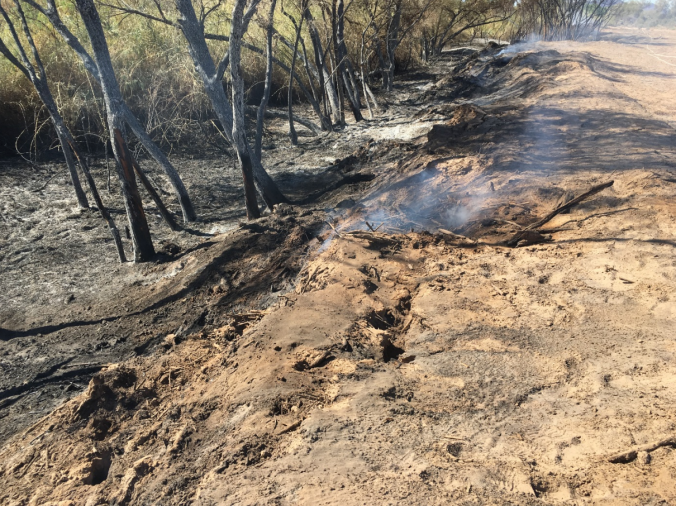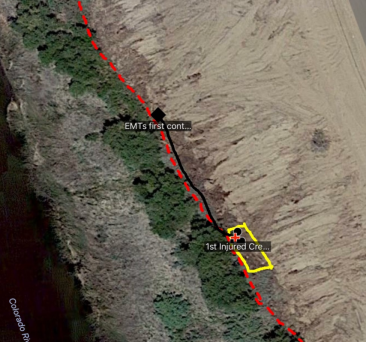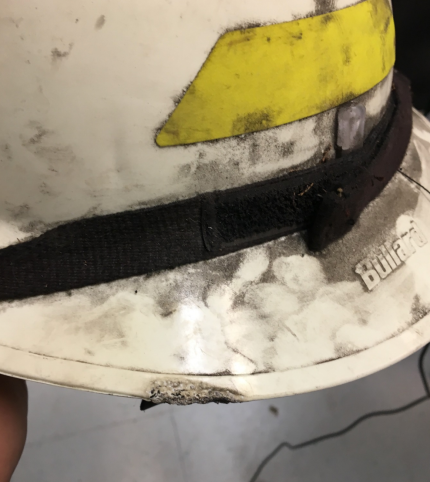This blog post was compiled using several excerpts from two separate documents on the Laguna Fire Burn Injuries.
At approximately 1010 a crew member from the Type 2 crew fell into an ash pit, after ground gave way on a mechanically constructed berm the crewmember was mopping up with a branch line. The crewmember advanced a hose line up the berm and upon reaching the top the employee stepped toward the downhill side facing the Colorado River and berm gave way.

The berm that gave way.
The employee went down to approximately the knee level in a void space created by burning material being consumed under the crust of the berm. The employee fell forward towards the downhill side adjacent the Colorado River. The employee had forward inertia and momentum which continued him downhill with a section of ash and dirt. The section was approximately 38 inches wide and 18 inches long. The employee extended their hands and arms to provide protection while falling forward. The employee sunk into the hot ash pit up to approximately the armpit and shoulder, additional hot rolling material followed the employee downslope encompassing lower extremities and upper torso.
As the employee was falling an adjacent crewmember heard the employee’s screaming. The witness employee was approximately 6 feet to the south on the same berm. The witness employee observed the employee who fell sinking up to the armpits and shoulders and then rolling forward. The employee also recounted seeing the employee who fell struggling to get out of the ash pit, and then once self-extricated beginning to walk/run around trying to get hot material off the employee’s body and personal protective equipment.
At approximately 1012 a witness employee began yelling for assistance and a radio to notify the crew overhead of an injury/incident. The witness employee generated a radio call as well as a physical call for additional assistance. At approximately 1013 several members of the crew including the crew boss, the foreman, and the squad bosses started toward the scene.

Overview of fire area and injury location.
At approximately 1024 Fish and Wildlife Engine 2162 with two emergency medical technicians arrived on scene to continue patient care. The emergency medical technicians continued to expose and evaluate the nature of the injuries. At approximately 1027 an update on the employee’s medical condition was given via radio to the incident commander.
The incident commander notified Arizona dispatch, requesting an ambulance to transport the employee and start the notification process to the fire staff. The crewmember was ambulatory and communicating. The decision was made to walk the injured employee to a waiting crew agency vehicle to be driven and rendezvous with the ambulance at the ICP.
It continues…
At approximately 1045 the DFFM Safety Officer called the IC to receive an update on the incident within an incident. The Safety Officer requested the area of the incident within the incident be flagged off to preserve the scene for the investigation process.
At approximately 1100 a crew member from the DFFM Type II crew began flagging off the area of the incident within an incident. The employee was approximately 7’ to the south of the location on the berm, the employee utilized hose line to cool the area and a tool to probe the area as the employee moved forward. The employee stepped through the berm into an ash pit. The employee had forward downhill momentum and “tucked and rolled” down the berm through the ash pit.

Second employee’s hard hat with burn damage.
The injured employee completed the flagging of the area. At approximately 1120 the injured employee notified the IC of the incident. The injured employee was evaluated by the emergency medical technicians on Fish and Wildlife Engine 2162. The employee suffered first-degree burns to the right ear, right upper arm (triceps area), left arm lower arm, right thigh, right and left shin, and right calf. The injured employee was wearing full PPE at the time of the incident.
The employee opted not to be transported to the hospital at that time because he was the ranking crew member present. The other crew overhead accompanied the previously injured employee to the emergency department. At approximately 1230 a supervisory crew member arrived back to the incident from the hospital. The injured employee was directed to go to the hospital and was driven in a crew vehicle to the hospital. The employee was evaluated, treated, and released by the emergency room with first-degree and possibly a few second-degree burns to travel home with the crew.
Do YOU think of mop-up as “dangerous”?
Does it matter if you do or don’t?
(Tell us in the comments)
Read both incident reports here: Laguna Fire Burn Injuries
Are you asking if mop up is dangerous??
LikeLike
We are asking if you THINK of it as dangerous…trying to get at the frame of mind we have as we enter mop-up mode.
Please share your thoughts!
LikeLike
Yes it’s in IRPG!🤠
LikeLike
Yes mop up is dangerous. Firefighters have a natural tendencies to let their guard down once the flames leave. Most of the line building is away from the direct flames but in mopup your in the pit. As fuels burn for days the crews are further in the black where the hazards of stump holes, ash pits, snags are more likely to be.
LikeLike
I retired as FMO on the Navajo reservation in 2011. While there, we had several instances of people stepping into these kind of hidden traps, with minor burns. This was especially true when our Navajo Scouts and hotshots were working in the Southwest. I found a bit of literature on this problem and wrote up a Safety Alert on it. You can find it by goggling “firefighters sustain burn injuries from ash pits”. We wound up gearing our folks up with the rip-stop, heavy duty nomex pants and providing additional training.
LikeLiked by 2 people
G’day Mate, Nice text. Regards, Mark Willetts
LikeLike
How about referring to them as Firefighters instead as employees?
LikeLike
Thank you John!
LikeLike
I think that many times firefighters are sent into unnecessary situations to mop up just for the sake of moping up. It could be near a snag patch or where numerous stump holes or ashpits are at. Fire leaders sometimes have tunnel vision when it comes to fire line tactics. If it’s not an immediate threat to the fireline then leave it alone. Stop having firefighters take unnecessary risk by doing unnecessary things. THINK!
LikeLiked by 1 person
Everything on the fire line is dangerous at times. As a safety officer I continuously ask the line personnel for feed back and remind them that if something doesn’t look right or they are uncomfortable with something then say something and don’t do it. Come up with an alternative that provides safety for those involved, maybe the best action is no action. You cant just throw out a statement that it’s the fire leaderships fault. They can’t see every twist , turn, snag and the hundreds of other hazards out on the line.
LikeLike
We can live in an imaginary land of wildland firefighting or we can face the facts.. The average crew member on a type 2 crew most likely has a low experience level. If given a task to complete they are going to trust that the leadership has already done a risk assessment and go do what they are told to do. I say this as a former type 2 crew member and squad boss and as a former hotshot. Crew members tend to let overhead do there thinking for them. Not all, but many do. So leadership at whatever level needs to consider if what is being done actually needs to be done. Knowing that many crew members can act like drones at times. How many times has a the average firefighter came to you and said something is unsafe and given you an alternate action? I would bet not many. Firefighters should always take there safety first but to many times they are trusting someone else to do it for them. So leadership needs to consider this and take responsibility for it.
LikeLike
but you can’t also provide for safety by putting it on the firefighters to say something when they feel uncomfortable. often times firefighters are quite comfortable before accidents occur. fireline leaders (not necessarily in this scenario, but in general) need to ask questions like “is mopping up hundreds of feet interior a necessary task?” just a thought…..
LikeLiked by 1 person
In my experience (33 years and counting) some the most serious injuries I’ve encountered were in the “mop up” phase. Trees fall, felling operations to secure containment are always hazardous, and berms can give way….I consider mop up to be important – something not taken care of can come back and bite you. It is a part of the job that is often groaned and complained about, but is important – and deserves and demands attention to get the job completed safely.
LikeLike